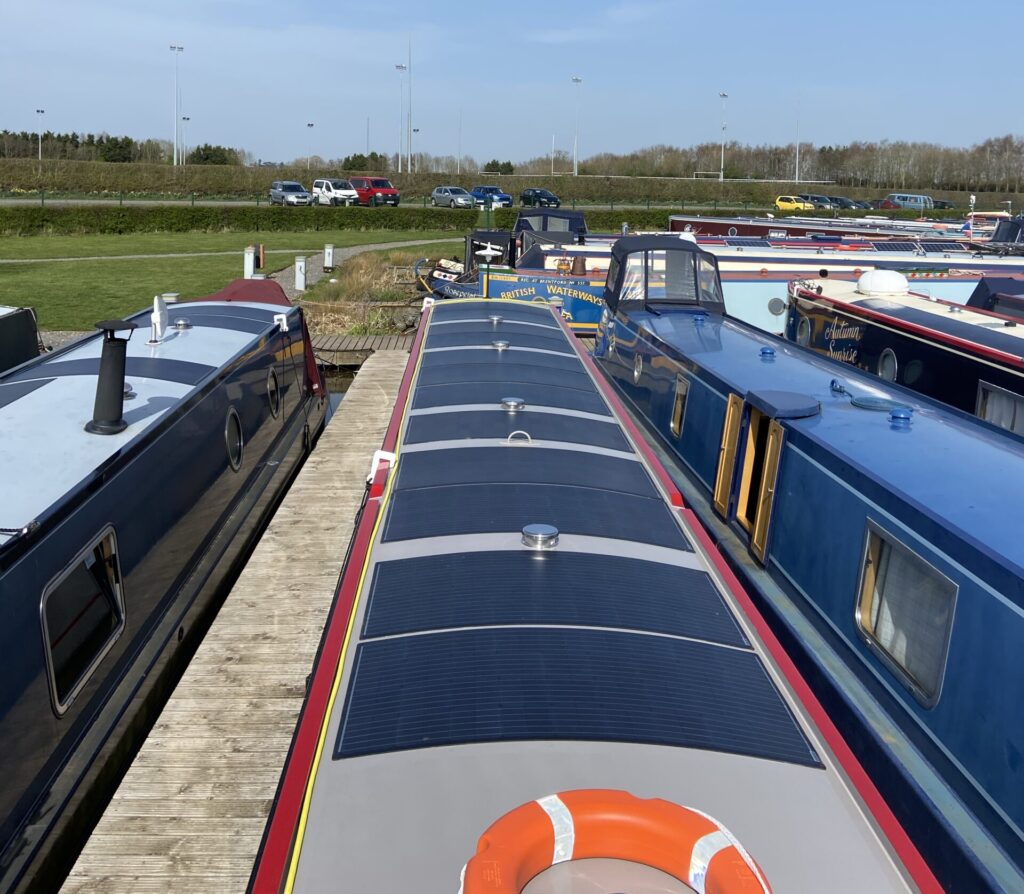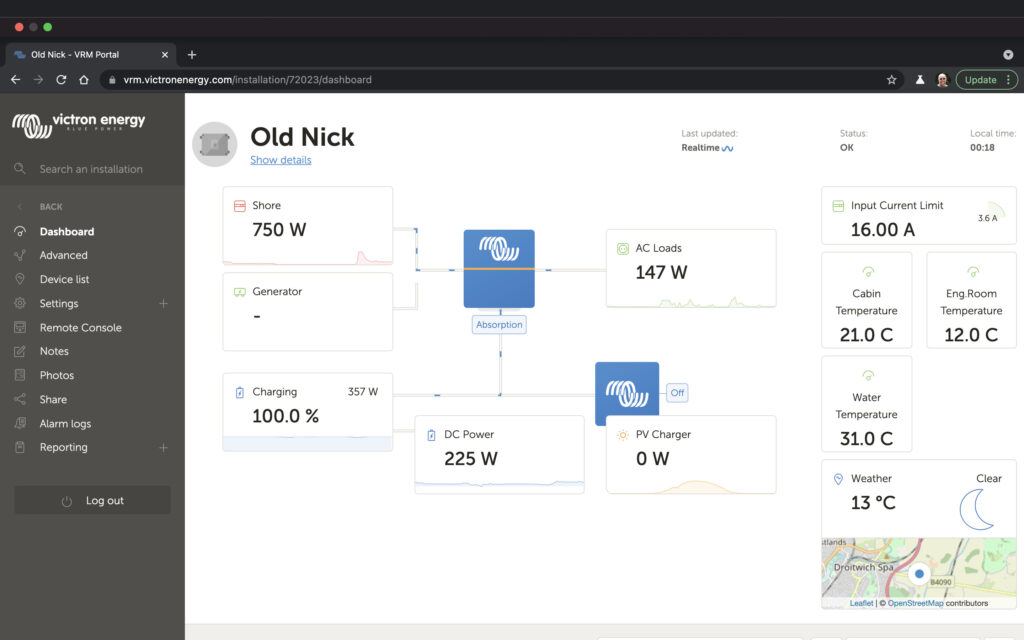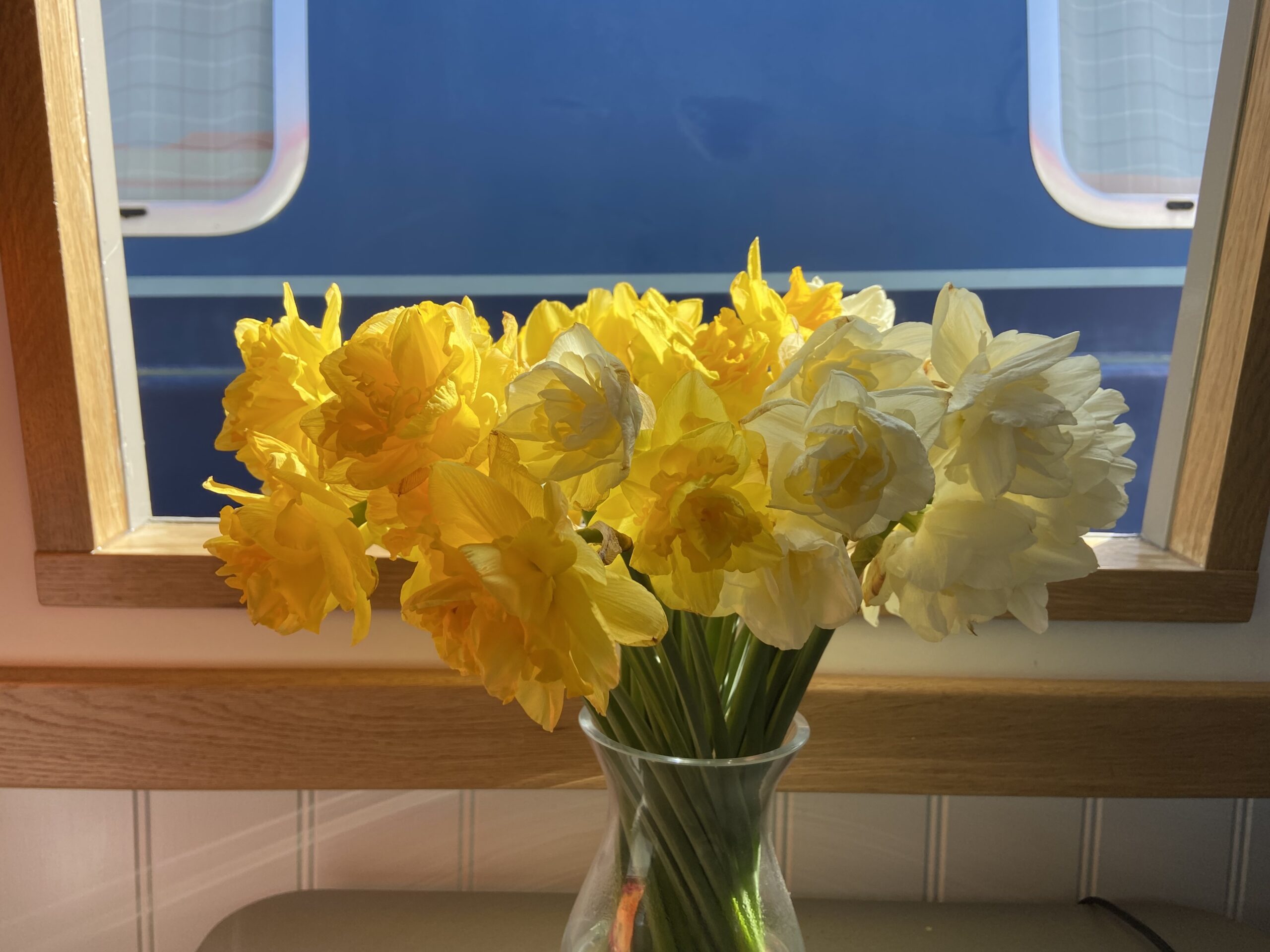We have always promised that we would be reporting about our real life experiences on board Old Nick. It has now been just over 3 months since we took delivery and – apart from a short trip back in December – we have been unable to go anywhere, because of lockdown. It’s very frustrating having a new toy and not being able to play with it, much as we love it here at the very peaceful Droitwich Spa Marina.
The one thing that we can actually report on is our solar yield and power usage. We can harvest data from the “Victron Remote Management Portal” or VRM. I need to explain what that is before we go any further.

Every day, our electrical data, from our Victron Energy Management System, is sent to Victron’s cloud server. They provide the service, free of charge, together with data visualisation tools, which provide an easy method of generating graphs and diagrams for specific data in a selected time period.

We have looked at the last 90 days, being as close to our three months as possible. Let’s start with a look at the solar power that we have generated.
It’s pretty easy to see from the first graphic below, that the sun is gradually gaining strength. It’s pretty exciting to see it so clearly and it’s a foretaste of what abundance is to come.

The next diagram (Fig 2) is also pretty interesting – whether you’re a solar panel geek or not! This is the solar panel Output Voltage and rather surprisingly, you can see that the output voltage is pretty stable over the same period. This shows that when it comes to solar panels, the voltage output is not a good measure of their performance.

Even on cloudy, overcast days in the depth of the winter, you will get a reasonable output voltage from the panels but, as Figure 3 shows, it is the output current that is the best measure of the solar panels performance. As Power = Voltage x Current and the voltage is pretty constant, you can see that the output current graph is almost identical in shape to the power graph.

Since launch, we have been on shore power, but using the Ortomate™ new “Eco Mode”, as outlined in this earlier post, we have really maximised our solar power. We are able to run most of our daily equipment; PCs, Sonos, recharge portable devices, boiling the kettle, water heating, etc. from the solar panels.
With continuous shore power and increasing solar power, the one piece of equipment we have not used is the Vetus GLX6,5SIC generator. Aside from, giving it a fortnightly half hour run, to ensure the fuel and cooling systems are all OK, we really have not put it through its paces. Unfortunately, it is a piece of kit that you will hopefully, only use infrequently, but when you do need it, it has to work and work well.
It’ll be interesting to look at how often and for how long we run it, whilst we are actually cruising. Although as we are heading towards summer and lots of lovely solar, the hope is that the answer to that question is “not very often or for short periods”.
PS – check out Mark Langley’s very complimentary review of Old Nick in the May 2021 edition of Waterways World.


Nice to see you geeking out over all the new toys. Sounds brilliant.
I am a panel geek.
Hi guys. Thanks for the recent update, it all bodes well for when the sun really puts his hat on.
I have already read the excellent article in WW and I have to say, Old Nick really does look superb and the technical spec on propulsion system and the “Technology Cupboard” as Mark described it look absolutely state of the art.
As you may know, we have a build slot booked with Ortomarine forJan 2023, and our current thinking is that we would probably go for a parallel hybrid system, mainly because we plan to do a fair bit of river cruising, including the tidal sections of The Thames and Trent, The Ribble Link and probably even The Wash and Severn Estuary runs. I had assumed that a series hybrid with a 10 kw motor, while perfect for lighter canal cruising would not have the grunt to cope with faster flowing rivers let alone the tidal races one is likely to have to deal with on some of the above named waterways. However, Mark’s article seems to suggest that rivers and even tidal waterways are within the capability of your series hybrid system. I would love to know your thoughts on this and to know if you have plans to tackle some of these more demanding waterways once the restrictions are lifted and you can start cruising. Thanks and regards
Matt & Pauline Parker
Hi Matt & Pauline,
Only time will tell whether our setup will fully cope with every condition and river we throw at it and we certainly want to cruise all of the places you mention. We are taking Old Nick on the Severn this weekend for a first taste of rivers and later this summer will tackle the Thames and possibly Avon. It is an important issue and one we will be writing about once we have more data.
All the best
Paul & Kay
Hi, just catching up on your forum, I was interested in an all electric NB but couldn’t wait so bought a Beta marine 43 powered boat in November. I have however, installed 1.4 KW of PV and a 600Ah @ 12V Victron lithium system including the Cerbo GX and have two temperature sensors, one bolted onto the engine near the alternator and one on the lithiums to check that they don’t get too warm as they are in the old battery box in the engine bay (it’s a trad). I see you have one for water temperature which is interesting because I am going to divert from the solar any excess to the calorifier using a 12V 600W immersion element. Can you tell how yours is installed please.
BTW, here is my live VRM: https://vrm.victronenergy.com/installation/94592/share/4e3e40ee
Hi Mark, Ortomarine found a small space on the Vetus calorifier where they could fit a standard temperature sensor. This goes to the Cerbo GX like your sensors and then is fed through to their Ortomate system via ModBus. It works very well and we just set the water temp to 48degs and heat the water three times a day. We are looking at whether a continuous pulsed type heating method might be more efficient. Hope this of interest. Thank you for reading the blog.
Thanks, sounds great if you are saying you control the water temp via Modbus. I think I will put an extended Victron sensor on a pipe clamp by the 55L calorifier, just to see how the temperature is doing. I reckon the solar dumping into the water should help a lot in the summer months, when the Webasto isn’t used a lot. I might even put a jacket on the calorifier, to add to the 25mm insulation.
Really interesting data that . Our Loire river houseboat has 14 x 375w panels on our roof, but for now only 10 are connected in a mixture of serial and parallel. Here on the Loire river near Saumur we get little output (100w at 90v) on cloudy days, but that jumps to 700 if there is direct sunlight. We are not that greedy in terms of installed electrical devices. The fridge/freezer is always on and so is the water heater. We cook mostly by gas, but do have a toaster, microwave, and an infrared cooker. A dishwasher and washing machine are also used sometimes. Solar panel input is not enough to power us in December or January. We need a regular boost from the diesel generator. An hour and a half daily seems to be what is required in the depths of winter to keep things stable despite a 48Kw lithium battery bank.